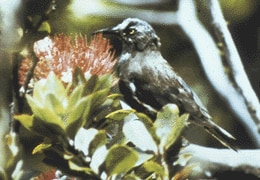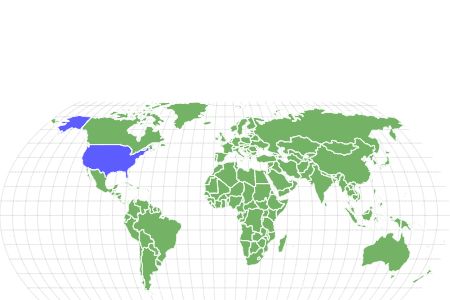Kaua’i ‘Ō‘ō
Moho braccatus
Calls could be heard up to a quarter mile away
Advertisement
Kaua’i ‘Ō‘ō Scientific Classification
- Kingdom
- Animalia
- Phylum
- Chordata
- Class
- Aves
- Order
- Passeriformes
- Family
- Mohoidae
- Genus
- Moho
- Scientific Name
- Moho braccatus
Read our Complete Guide to Classification of Animals.
Kaua’i ‘Ō‘ō Conservation Status
Kaua’i ‘Ō‘ō Facts
- Prey
- Insects
- Main Prey
- Moths, spiders
- Name Of Young
- Chick
- Group Behavior
- Solitary
- Pair
- Fun Fact
- Calls could be heard up to a quarter mile away
- Biggest Threat
- Predators, habitat loss, disease
- Most Distinctive Feature
- Yellow leg feathers
- Distinctive Feature
- Rufous rump
- Other Name(s)
- ‘ō‘ō ʻāʻā
- Incubation Period
- 2-3 weeks
- Habitat
- Subtropical forests
- Predators
- Rats, mongooses, pigs
- Diet
- Omnivore
- Lifestyle
- Diurnal
- Favorite Food
- Nectar
- Special Features
- Long, curved bill
- Location
- Hawaiian island of Kaua’i
- Nesting Location
- Tree cavities
Kaua’i ‘Ō‘ō Physical Characteristics
- Color
- Brown
- Grey
- Yellow
- Blue
- White
- Gold
- Skin Type
- Feathers
- Length
- 7.5-8.5 inches
- Venomous
- No
- Aggression
- Low
View all of the Kaua’i ‘Ō‘ō images!
Known for its loud and distinctive call, the Kaua’i ‘ō‘ō was a member of the family Mohoidae or Hawaiian honeyeaters. As of 1987, it represented the last remaining species in its family. However, predation by invasive species, habitat loss, and mosquito-borne diseases decimated the remaining Kaua’i ‘ō‘ō. No one has seen or heard a Kaua’i ‘ō‘ō since 1987, and the species was declared extinct by the IUCN in 2000. Despite this declaration, some people continue to believe that Kaua’i ‘ō‘ō still live on the island of Kaua’i.
5 Kaua’i ‘Ō‘ō Amazing Facts
- The Kaua’i ‘ō‘ō had a yellow iris, which made it the only known member of its family with this feature.
- Kaua’i ‘ō‘ō possessed a long, curved bill that it used to collect nectar from flowering trees and other plants.
- In Hawaiian, its name ‘ō‘ō ʻāʻā comes from the onomatopoeic sound of its call (‘ō‘ō) and the word ʻāʻā, meaning “dwarf.”
- Kaua’i ‘ō‘ō made loud, flute-like calls that could sound very erratic and hollow.
- Male and female Kaua’i ‘ō‘ō paired and mated for life and made their nests in the cavities of trees.
Where to Find Kaua’i ‘Ō‘ō
Prior to 1987, you could find Kaua’i ‘ō‘ō on the Hawaiian island Kaua’i. Up until then, they frequently lived in the subtropical forests on the island. Kaua’i ‘ō‘ō lived and made their nests in the cavity of trees in thickly forested canyons and other areas with old-growth trees. Leading up to their decline, habitat loss, diseases, and predators drove them out of their traditional lowland habitats. The remaining Kaua’i ‘ō‘ō retreated to high-elevation montane forests, such as those in the Alaka’i Wilderness Preserve. Today, no Kaua’i ‘ō‘ō remain on Kaua’i based on extensive surveys of the island.
Kaua’i ‘Ō‘ō Scientific Name
The Kaua’i ‘ō‘ō belonged to the Hawaiian honeyeater family Mohoidae. Kaua’i ‘ō‘ō got their common name from their location, as they were endemic to the island of Kaua’i in Hawaii. The genus name, Moho, derives from the Hawaiian ‘ō‘ō, an onomatopoeic descriptor of the sounds of their calls. Meanwhile, the species name, braccatus, derives from the Latin word brāca, meaning “breeches” or “trousers,” and the suffix -ātus, used to form adjectives from nouns indicating possession of a thing or feature. Taken together, braccatus roughly translates to “wearing breeches.” Therefore, the scientific name of the Kaua’i ‘ō‘ō likely references its golden yellow leg feathers. These feathers stood out from its otherwise blackish-gray and brown coloration and gave it the appearance of wearing pants.
The native people of Hawai’i called the Kaua’i ‘ō‘ō by the name ‘ō‘ō ʻāʻā. As previously mentioned, ‘ō‘ō mimics the sounds of the bird’s call, while ʻāʻā translates as “dwarf.” This name makes sense, given that the Kaua’i ‘ō‘ō ranked as one of the smallest members of its family.
Kaua’i ‘Ō‘ō Size, Appearance, and Behavior

Male and female Kaua’i ‘ō‘ō did not differ in appearance much, outside of their size.
©Robert Shallenberger/Wikimedia Commons
Male and female Kaua’i ‘ō‘ō looked very similar in terms of appearance, except the females measured slightly smaller. They ranked as one of the smallest members of their family, measuring approximately 7.5 to 8.5 inches long. The head, wings, and tail feathers were all black, the underparts were brown, and the rump and flanks were rufous. Meanwhile, the throat and breast featured black and white bars, while the leg feathers appeared bright golden yellow. Like other honeyeaters, their bill was long, sharp, and slightly curved, which allowed them to collect nectar from flowers efficiently. However, unlike other members of its family, the Kaua’i ‘ō‘ō possessed yellow irises.
Kaua’i ‘Ō‘ō Evolution and History
Based on recent taxonomic evidence, the Mohoidae family emerged sometime during the early Miocene. This means that the Kaua’i ‘ō‘ō and its relatives originated somewhere between 15 and 20 million years ago. Close relatives of the Kaua’i ‘ō‘ō include the gray hypocolius in the family Hypocoliidae and – more distantly – the hylocitrea, or yellow-flanked whistler, in the family Hylocitredidae. Further up the line, you find the silky flycatchers, waxwings, and palmchat, all of which belong to the superfamily Bombycilloidea. Historically, the Hawaiian nobility used the feathers of the Kaua’i ‘ō‘ō and other Hawaiian honeyeaters to create robes and capes.
Kaua’i ‘Ō‘ō Diet
The Kaua’i ‘ō‘ō was a nectarivore that used its long, curved bill to collect nectar from plants. Some of its favorite sources of nectar included ‘ohi’a lehua trees, lapalapa trees, and Hawaiian lobeliods. Additionally, they also ate fruit and a range of insects, including moths, spiders, caterpillars, millipedes, centipedes, and crickets. Kaua’i ‘ō‘ō were diurnal and did most of their hunting within a limited area around their nest.
Kaua’i ‘Ō‘ō Predators and Threats
The Hawaiian islands had almost no natural predators until relatively recently. This lack of predators allowed native species like the Kaua’i ‘ō‘ō to thrive without fear of predation. All this changed with the arrival of Europeans and Americans in the late 18th century. Shortly thereafter, several invasive species found their way to the various Hawaiian islands. These invasive species lacked their own natural predators, which allowed them to flourish on the islands. They quickly spread and decimated many native animals, including the Kaua’i ‘ō‘ō and other Hawaiian honeyeaters. Some of the animals that preyed on the Kaua’i ‘ō‘ō include the Polynesian rat, small Indian mongoose, and domestic pig.
Other threats to the Kaua’i ‘ō‘ō included mosquito-borne diseases and habitat loss. Kaua’i ‘ō‘ō require old-growth trees with cavities to build their nests. As more and more Kaua’i’s lowland forests disappeared to make way for human settlements and agriculture, the Kaua’i ‘ō‘ō were left with fewer and fewer places to reproduce. They retreated to higher-elevation forests, but most of the plants there lacked suitable cavities for their nests. Inclement weather also contributed to their downfall, as strong hurricanes felled many older trees at high elevations that they could have used for nesting.
Kaua’i ‘Ō‘ō Reproduction, Young and Molting
According to the limited research gathered before they went extinct, Kaua’i ‘ō‘ō bred sometime between late May and early June. Males and females engaged in harmonious duets and mated for life. They likely only reproduced once yearly, but they may have laid several clutches. Kaua’i ‘ō‘ō made their nests in the cavities of trees, particularly old-growth trees in low-elevation subtropical forests. Common host plants included ‘ohi’a, lapalapa, and other native shrubs with dense foliage. Nests often looked elliptical in shape and consisted of grass roots, moss, twigs, and other plant material. Both males and females defended their nesting territory from other birds. Females laid an unknown number of eggs, and incubation likely lasted for 2 to 3 weeks. Other reproductive factors remain a mystery, including when the young birds grew old enough to take care of themselves.
Kaua’i ‘Ō‘ō Population
Before the 20th century, you could find Kaua’i ‘ō‘ō throughout the forested areas of Kaua’i. However, by the 1960s, only around 34 birds remained on the island. This number fell to just one mated pair in 1981. Sometime between 1981 and 1987, the female bird disappeared, which left only one male bird in the entire species. The last recording of this solitary male was made in 1987. Since then, no video or sound recordings have captured evidence of Kaua’i ‘ō‘ō. As a result, the IUCN listed the Kaua’i ‘ō‘ō as an Extinct species in 2000.
Related Animals…
View all 77 animals that start with KKaua’i ‘Ō‘ō FAQs (Frequently Asked Questions)
Were Kaua’i ‘Ō‘ō carnivores, herbivores, or omnivores?
Kaua’i ‘ō‘ō were nectarivorous songbirds whose diet primarily consisted of nectar derived from flower plants. That said, Kaua’i ‘ō‘ō also eat the flesh of fruits and insects, which technically classifies them as omnivores.
Where were Kaua’i ‘Ō‘ō found?
Prior to their disappearance, you could find Kaua’i ‘ō‘ō throughout the subtropical forests on the Hawaiian island of Kaua’i.
When did the Kaua’i ‘ō‘ō go extinct?
The last female Kaua’i ‘ō‘ō disappeared in 1982. Meanwhile, the last recording of a male Kaua’i ‘ō‘ō song was taken in 1987. Successive surveys failed to find any traces of either male or female Kaua’i ‘ō‘ō throughout their native habitat. In 2000, the IUCN listed the Kaua’i ‘ō‘ō as an extinct species.
Can the Kaua’i ‘ō‘ō be brought back?
Theoretically, scientists could bring back Kaua’i ‘ō‘ō if they could recover sufficient amounts of DNA material. They could attempt to reverse engineer Kaua’i ‘ō‘ō by using that material to create a clone of the deceased animal.
Thank you for reading! Have some feedback for us? Contact the AZ Animals editorial team.
Sources
- Bird Note, Available here: https://www.birdnote.org/listen/shows/kauai-oo-hawaiian-forest-bird
- Hawaii Department of Land and Natural Resources, Available here: https://dlnr.hawaii.gov/wildlife/birds/kauai-oo/
- Island Conservation, Available here: https://www.islandconservation.org/extinction-kauai-%CA%BBo%CA%BBo/

















